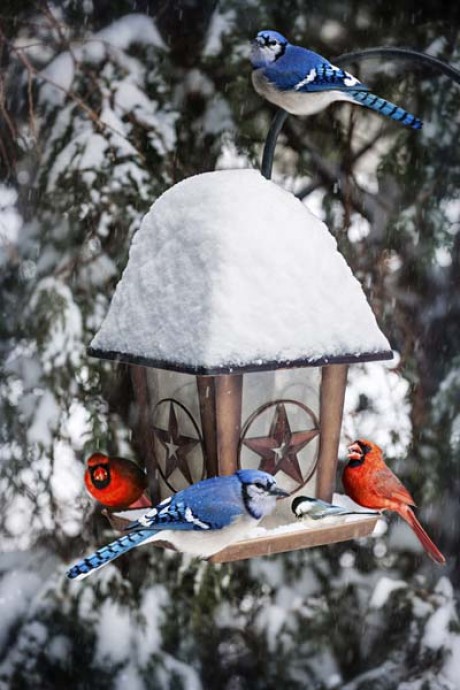Winter is for the birds!
You can create an environment to attract feathered visitors
By Carole Howell
I've always enjoyed the summer months the most, when vegetables come fresh from the garden and you don't have to dress head to toe just to fetch the mail. Winter, on the other hand, does have its perks, including homemade soup and holidays.
Another winter treat includes the colorful assemblage of birds outside my window, including my personal favorite, the male northern cardinal and his mate. Our state bird always distracts me with a flash of crimson against an otherwise drab landscape.
Other types of year-round residents include the tufted titmouse, Carolina chickadees, house finches, American goldfinches, and several types of woodpeckers. Warblers and songbirds headed south in the fall and early winter use North Carolina as a rest area. On the coast, inland freshwater birds, sandpipers, and American woodcocks forage in boggy areas.
"Many people enjoy birdwatching in the winter months," says Curtis Smalling, director of Land Bird Conservation at Audubon North Carolina. "Even small children can enjoy birdwatching, especially if it's accompanied by some fun crafts and activities. You may even spark a new and year-round interest."
Food, water, shelter
Three simple keys to attracting a colorful and interesting display are food, water and shelter.
Smalling says that black oil sunflower and thistle seeds appeal to a variety of feathered visitors. As an amateur birdwatcher, I've always purchased pre-mixed birdseed, but most veteran birders create their own mix or feed sunflowers in one feeder and thistle seed in another. Simply combine your seeds according to the birds you want to attract and what your budget will allow; more birds for your buck. Chickadees, woodpeckers and even pine warblers enjoy a suet block, which provides nutrition birds need to keep warm.
"For shelter, place your feeders close to bushes and brush," says Smalling. "A shelter about 10 feet away from your feeder provides a quick escape from ambushing felines or hawks looking for their favorite foods as well." A discarded Christmas tree is ideal for a quick retreat.
Clean water in a shallow container is the third key. Just remember to break the ice on extremely cold days.
Include the kids
Children, in particular, enjoy crafting delicious decorations to attract birds. You can turn it into a learning experience by playing "I Spy" for different colors and types of birds, starting a collection of photos or drawings of your winter visitors, and identifying and researching the birds you see. Older children may even want to join in the annual Great Backyard Bird Count, an international project co-sponsored by the Cornell Lab of Ornithology and the National Audubon Society.
So set your winter table, hot chocolate in hand, and watch your visitors enjoy the banquet from the warm side of a frosty window. It's sure to help make the dark winter months brighter while you wait for spring.
Homemade bird treats
Here are two tasty winter projects that add color and decoration to your winter landscape, provide an irresistible buffet for birds, and give kids of all ages a fun activity to combat cabin fever.
Don't be discouraged if your birds are a little wary of your new feeder or your homemade offerings. Birds find food by sight, so a little seed sprinkled on the ground will help them get the idea.
Snowy Doughnuts
You'll need 12 small, powdered sugar-coated doughnuts (and more for snacking) and four yards of ¼ inch-wide red yarn, ribbon or raffia. Cut your ribbons into 12-inch lengths. Loop a ribbon through each doughnut and hang them Christmas ornament-style from bushes and trees.
Garland Ambrosia
Using a tapestry needle and heavy thread, string combinations of whole fresh cranberries, raw peanuts in the shell, thin apple and orange slices, raisins, soft puppy food, unsweetened oat cereal, bread chunks and stale popcorn. A spool of wire also works well for stringing and eliminates the need for a needle. Drape these in your bushes and watch the birds enjoy your decorations.
-
Share this story:
{ampz:Custom share for module}